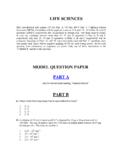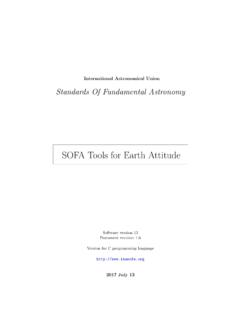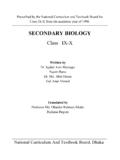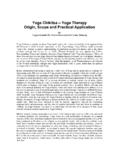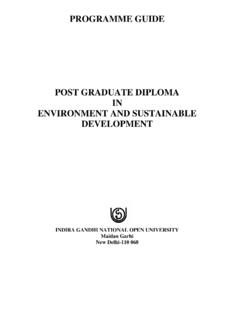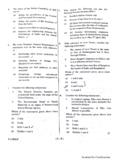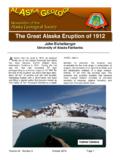Transcription of CSIR-UGC National Eligibility Test (NET) for Junior ...
1 CSIR-UGC National Eligibility Test (NET) for Junior Research Fellowship and Lecturer-ship earth , ATMOSPHERIC, OCEAN AND PLANETARY SCIENCES. PAPER I (PART B). 1. The earth and the Solar System: Milky Way and the solar system. Modern theories on the origin of the earth and other planetary bodies. earth s orbital parameters, Kepler s laws of planetary motion, Geological Time Scale; Space and time scales of processes in the solid earth , atmosphere and oceans. Radioactive isotopes and their applications. Meteorites Chemical composition and the Primary differentiation of the earth . Basic principles of stratigraphy.
2 Theories about the origin of life and the nature of fossil record. earth s gravity and magnetic fields and its thermal structure: Concept of Geoid and, spheroid;. Isostasy. 2. earth Materials, Surface Features and Processes: Gross composition and physical properties of important minerals and rocks; properties and processes responsible for mineral concentrations; nature and distribution of rocks and minerals in different units of the earth and different parts of India. Physiography of the earth ; weathering, erosion, transportation and deposition of earth s material;. formation of soil, sediments and sedimentary rocks; energy balance of the earth s surface processes.
3 Physiographic features and river basins in India 3. Interior of the earth , Deformation and Tectonics Basic concepts of seismology and internal structure of the earth . Physico-chemical and seismic properties of earth s interior. Concepts of stress and strain. Behaviour of rocks under stress; Folds, joints and faults. Earthquakes their causes and measurement. Interplate and intraplate seismicity. Paleomagnetism, sea floor spreading and plate tectonics. 4. Oceans and Atmosphere Hypsography of the continents and ocean floor continental shelf, slope, rise and abyssal plains. Physical and chemical properties of sea water and their spatial variations.
4 Residence times of elements in sea water. Ocean currents, waves and tides, important current systems, thermohaline circulation and the oceanic conveyor belt. Major water masses of the world s oceans. Biological productivity in the oceans. Motion of fluids, waves in atmospheric and oceanic systems. Atmospheric turbulence and boundary layer. Structure and chemical composition of the atmosphere, lapse rate and stability, scale height, geopotential, greenhouse gases and global warming. Cloud formation and precipitation processes, air- sea interactions on different space and time scales. Insolation and heat budget, radiation balance, general circulation of the atmosphere and ocean.
5 Climatic and sea level changes on different time scales. Coupled ocean-atmosphere system, El Nino Southern Oscillation (ENSO). General weather systems of India, - Monsoon system, cyclone and jet stream, Western disturbances and severe local convective systems, distribution of precipitation over India. Marine and atmospheric pollution, ozone depletion. 5. Environmental earth Sciences Properties of water; hydrological cycle; water resources and management. Energy resources, uses, degradation, alternatives and management; Ecology and biodiversity. Impact of use of energy and land on the environment. Exploitation and conservation of mineral and other natural resources.
6 Natural hazards. Elements of Remote Sensing. PAPER I (PART C). I. GEOLOGY. 1) MINERALOGY AND PETROLOGY: Concept of point group, space group, reciprocal lattice, diffraction and imaging. Concepts of crystal field theory and mineralogical spectroscopy. Lattice defects (point, line and planar). Electrical, magnetic and optical properties of minerals. Bonding and crystal structures of common oxides, sulphides, and silicates. Transformation of minerals polymorphism, polytypism, and polysomatism. Solid solution and exsolution. Steady-state geotherms. Genesis, properties, emplacement and crystallization of magmas. Phase equilibrium studies of simple systems, effect of volatiles on melt equilibria.
7 Magma-mixing, - mingling and -immiscibility. Metamorphic structures and textures; isograds and facies. Mineral reactions with condensed phases, solid solutions, mixed volatile equilibria and thermobarometry. Metamorphism of pelites, mafic-ultra mafic rocks and siliceous dolomites. Material transport during metamorphism. P-T-t path in regional metamorphic terrains, plate tectonics and metamorphism. Petrogenetic aspects of important rock suites of India, such as the Deccan Traps, layered intrusive complexes, anorthosites, carbonatites, charnockites, alkaline rocks, Kimberlites, ophiolites and granitoids. 2) STRUCTURAL GEOLOGY AND GEOTECTONICS: Theory of stress and strain.
8 Behaviour of rocks under stress. Mohr circle. Various states of stress and their representation by Mohr circles. Different types of failure and sliding criteria. Geometry and mechanics of fracturing and conditions for reactivation of pre-existing discontinuities. Common types of finite strain ellipsoids. L-, L-S-, and S-tectonic fabrics. Techniques of strain analysis. Particle paths and flow patterns. Progressive strain history. Introduction to deformation mechanisms. Role of fluids in deformation processes. Geometry and analyses of brittle-ductile and ductile shear zones. Sheath folds. Geometry and mechanics of development of folds, boudins, foliations and lineations.
9 Interference patterns of superposed fold. Fault-related folding. Gravity induced structures. Tectonic features of extensional-, compressional-, and strike-slip-terrains and relevance to plate boundaries. mantle plumes. Himalayan Orogeny; concept of super continent, their assembly and breakup. 3) PALEONTOLOGY AND ITS APPLICATIONS: Theories on origin of life. Organic evolution Punctuated Equilibrium and Phyletic Gradualism models. Mass extinctions and their causes. Application of fossils in age determination and correlation. Paleoecology, Life habitats and various ecosystems, Paleobiogeography. Modes of preservation of fossils and taphonomic considerations.
10 Types of microfossils. Environmental significance of fossils and trace fossils. Use of microfossils in interpretation of sea floor tectonism. Application of micropaleontology in hydrocarbon exploration. Oxygen and Carbon isotope studies of microfossils and their use in paleoceanographic and paleoclimatic interpretation. Important invertebrate fossils, vertebrate fossils, plant fossils and microfossils in Indian stratigraphy. 4) SEDIMENTOLOGY AND STRATIGRAPHY: Classification of sediments and sedimentary rocks ; elastic, volcanoclastic and chemical. Classification of elastic rocks. Flow regimes and processes of sediment transport.




